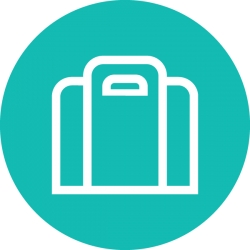Strategies for
Key Strategies
- Foster, retain, and attract a highly educated workforce.
- Foster a variety of businesses and industries.
- Connect Utah to economies throughout the U.S. and the world to avoid being overly dependent on any single economy.
- Significantly improve Utah’s air quality.
- Ensure people can afford to live and do business in Utah.
- Ensure convenient movement of people and goods.
This vision, created by Utahns, for Utahns, establishes a clear context, framework, and direction for policy discussions and actions to achieve the future Utahns want. Although government will play an important role, Utahns recognize that achieving the vision will also require a concerted, cooperative effort by individuals, families, businesses, and other organizations in the private sector.
The strong, robust economy that Utahns envision for the future will be the result of many decisions and actions across many topics. Most of the following strategies propose steps that will need to be taken in other topics addressed in the Your Utah, Your Future vision. For more detailed information on those specific strategies and others, please click on the strategies link for each topic.
Strategies
1. Ensure Utah has a highly educated workforce by implementing proven education improvement strategies that are backed by significant and stable funding.
- See education vision for detailed education strategies.
- Benefits for jobs and the economy:
- Increases Utahns’ earning potential and improves job prospects, which allow Utahns to achieve a better quality of life for themselves and their children
- Ensures the workforce meets the needs of a wide range of employers
- Increases likelihood that people will be civically engaged through voting and volunteering
- Reduces the amount of money needed for social services, as the population is better equipped to succeed in the workforce
2. Ensure Utah’s economy is resilient to local, national, and international economic changes.
- Ensure a diverse economy that is not overly reliant on any one industry.
- Connect Utah’s economy to other economies throughout the U.S. and the world to avoid becoming overly dependent on any single economy.
- Improve Utah’s resilience to disasters to avoid long-term devastating economic impacts.
3. Significantly improve Utah’s air quality, and maintain clean air year-round and for decades to come, despite population growth.
- See air quality vision for detailed air quality strategies.
- Benefits for jobs and the economy:
- Ensures Utah remains attractive to businesses and employees
- Cleans the air sufficiently to accommodate new, or the expansion of existing, businesses
- Improves the health of Utahns
4. Develop and pursue a balanced, comprehensive economic development strategy to strengthen and protect existing industry clusters while aggressively pursuing the establishment of new clusters.
- Regularly update the economic development strategy.
5. Maintain affordable housing and cost of living
- See housing and cost of living vision for detailed housing strategies.
- Benefits for jobs and the economy:
- Attracts and retains businesses and their employees
- Ensures that Utahns and their children can afford to stay and live in Utah
- Allows Utahns to spend more on other goods and services, as well as save for the future
- Ensures low-wage earners can afford to live in good neighborhoods with access to jobs, good schools, and healthcare
5. Ensure everybody has full and equal access to the opportunities that will help them succeed.
- Ensure all Utahns have access to a high-quality education.
- Maintain an affordable cost of living by providing a variety of housing and convenient transportation options that reduce household costs.
- Improve opportunities for all Utahns to live in safe communities that have a healthy environment, and provide easy access to services and amenities such as good schools, healthcare, recreation, healthy food, shopping, jobs, etc.
- Reduce concentrations of poverty by providing better access to transportation, jobs, housing, and other services across Utah.
6. Ensure that people and goods can conveniently travel throughout Utah and connect to places outside the state.
- Maintain and improve the convenience of taking public transportation, driving, walking, and biking.
- Locate jobs and educational opportunities near high-speed transportation, so Utahns can easily access them.
- Encourage housing to be built near employment and civic centers, downtowns, public transportation, and schools.
- Make Utah a transportation hub, with many flights and high-speed transportation options that connect Utah to other cities, states, and nations.
- Address the needs of the growing freight industry (air, rail, and truck).
- See transportation and communities vision for more detailed strategies.
- Benefits for jobs and the economy:
- Reduces household transportation costs
- Reduces costs and improves efficiency for businesses
- Attracts businesses that ship goods around the country and the world
- Attracts employers and employees by providing a high quality of life
- Fosters international tourism and increases visitor spending
- Establishes Utah as a regional hub, drawing jobs, employees, and economic activity from around the West
7. As metropolitan areas grow, ensure land is preserved for businesses and industries.
- Preserve large sites for clusters of businesses and their supporting suppliers and customers.
- Preserve sites for manufacturing, distribution, and other businesses that require large parcels of land.
- Consider the location of existing and potential future businesses when planning infrastructure and communities.
- Develop town, business, and industrial centers on regional transportation corridors.
- See transportation and communities vision for more detailed strategies.
8. Ensure residents and tourists have good access to recreational facilities.
- See recreation vision for detailed recreation strategies.
- Benefits for jobs and the economy:
- Ensures Utahns have access to recreational opportunities they consider essential to their high quality of life
- Draws employers and jobs to Utah
- Stimulates the economy as tourism brings money into Utah
9. Foster agriculture as a valued industry.
- See agriculture vision for detailed agriculture strategies.
- Benefits for jobs and the economy:
- Improves the economy in rural areas of the state
- Improves the ability to eat locally grown food
10. Keep energy costs relatively low, while diversifying energy sources and becoming more energy self-sufficient.
- See energy vision for detailed energy strategies.
- Benefits for jobs and the economy:
- Keeps household and business costs affordable
- Makes Utah attractive to businesses
- Produces jobs and revenue from Utah’s diverse energy resources
- Improves air quality
11. Ensure Utah has an affordable, long-term water supply.
12. Responsibly use public lands to benefit the economy, particularly by preserving the lands’ natural beauty and by promoting outdoor recreation and energy development.


